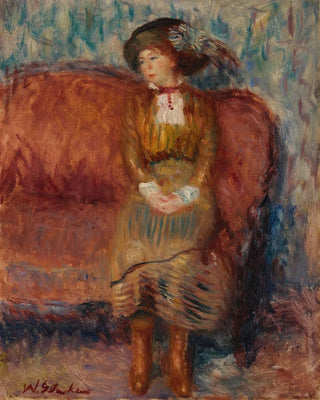Art print | Woman sitting on a red sofa - William James Glackens


View from behind

Frame (optional)
In the vibrant universe of early 20th-century American art, the art print "Femme assise sur un canapé rouge" by William James Glackens stands out for its ability to capture the very essence of modernity. This canvas, imbued with palpable intimacy, invites the viewer to immerse themselves in a frozen moment of life, where the woman, serene and contemplative, appears to indulge in her thoughts within a space filled with warmth and comfort. The color palette chosen by Glackens, dominated by deep reds and touches of light, evokes an atmosphere that is both soothing and stimulating, demonstrating the artist's skill in playing with human emotions through color and composition.
Style and uniqueness of the work
Glackens' style, often associated with the Impressionist movement, is characterized by a bold approach to color and light. In "Femme assise sur un canapé rouge," the artist employs a loose brushwork technique, giving the canvas an almost lively dynamism. The blurred contours and suggested forms allow the work to breathe, creating a dialogue between shadow and light that emphasizes the presence of the female figure. The woman, dressed in a gown that delicately contours her silhouette, is placed within a frame that feels both intimate and universal, evoking themes of solitude and contemplation. The rich texture of the brushstrokes and the harmony of hues contribute to an atmosphere that transcends the simple portrait to become a true psychological study.
The artist and his influence
William James Glackens, an emblematic figure of American art, established himself as a pioneer of modernism. Influenced by his European contemporaries, he integrated elements of Post-Impressionism while developing a style that is uniquely his own. Glackens was not only a talented painter but also a chronicler of his time, capturing the social and cultural transformations of his era. His work has inspired many artists who followed, contributing to the emergence of a distinctive American art. Through "Femme assise sur un canapé rouge," he shows us

Matte finish

View from behind

Frame (optional)
In the vibrant universe of early 20th-century American art, the art print "Femme assise sur un canapé rouge" by William James Glackens stands out for its ability to capture the very essence of modernity. This canvas, imbued with palpable intimacy, invites the viewer to immerse themselves in a frozen moment of life, where the woman, serene and contemplative, appears to indulge in her thoughts within a space filled with warmth and comfort. The color palette chosen by Glackens, dominated by deep reds and touches of light, evokes an atmosphere that is both soothing and stimulating, demonstrating the artist's skill in playing with human emotions through color and composition.
Style and uniqueness of the work
Glackens' style, often associated with the Impressionist movement, is characterized by a bold approach to color and light. In "Femme assise sur un canapé rouge," the artist employs a loose brushwork technique, giving the canvas an almost lively dynamism. The blurred contours and suggested forms allow the work to breathe, creating a dialogue between shadow and light that emphasizes the presence of the female figure. The woman, dressed in a gown that delicately contours her silhouette, is placed within a frame that feels both intimate and universal, evoking themes of solitude and contemplation. The rich texture of the brushstrokes and the harmony of hues contribute to an atmosphere that transcends the simple portrait to become a true psychological study.
The artist and his influence
William James Glackens, an emblematic figure of American art, established himself as a pioneer of modernism. Influenced by his European contemporaries, he integrated elements of Post-Impressionism while developing a style that is uniquely his own. Glackens was not only a talented painter but also a chronicler of his time, capturing the social and cultural transformations of his era. His work has inspired many artists who followed, contributing to the emergence of a distinctive American art. Through "Femme assise sur un canapé rouge," he shows us






